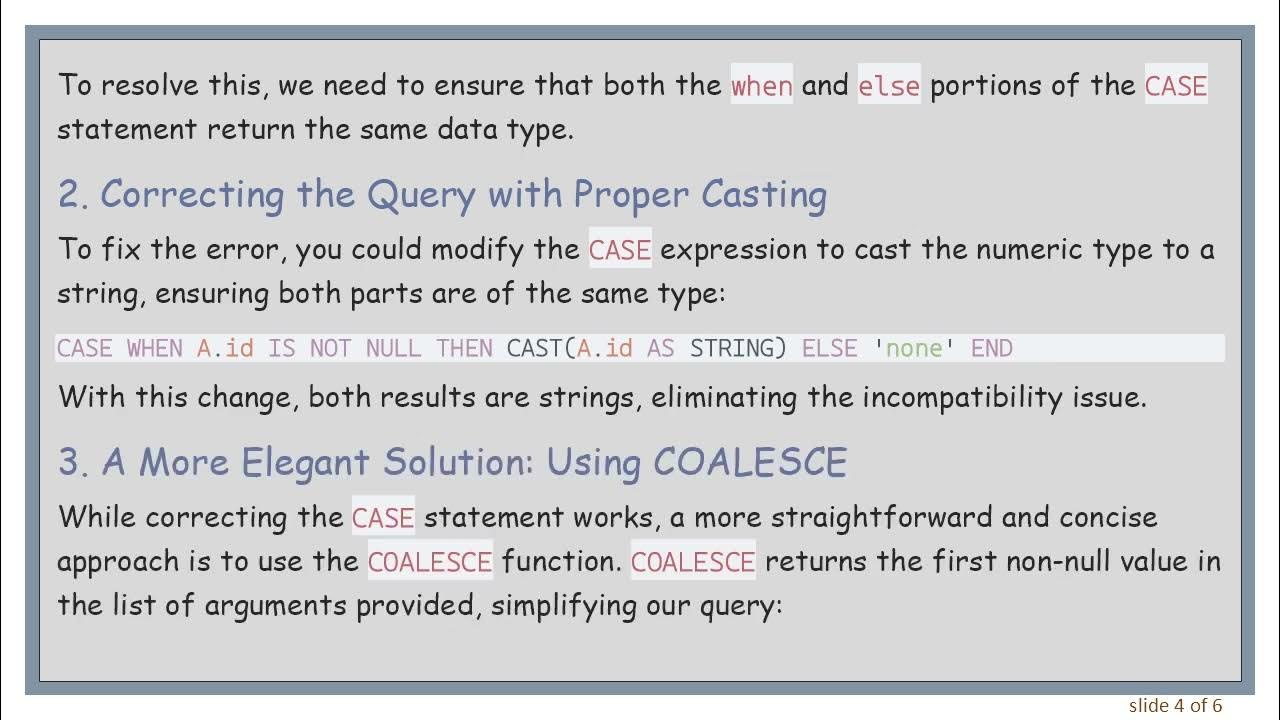Solving SQL Errors: CASE and CAST Gotcha

Details
| Title | Solving SQL Errors: CASE and CAST Gotcha |
| Author | vlogize |
| Duration | 1:39 |
| File Format | MP3 / MP4 |
| Original URL | https://youtube.com/watch?v=67d3YYeZ2I8 |
Description
Learn how to resolve errors in SQL when using `CASE` and `CAST` with numeric and NULL values. Get easy-to-understand solutions and best practices here.
---
This video is based on the question https://stackoverflow.com/q/77412879/ asked by the user 'DDS' ( https://stackoverflow.com/u/9443581/ ) and on the answer https://stackoverflow.com/a/77413094/ provided by the user 'Joel Coehoorn' ( https://stackoverflow.com/u/3043/ ) at 'Stack Overflow' website. Thanks to these great users and Stackexchange community for their contributions.
Visit these links for original content and any more details, such as alternate solutions, latest updates/developments on topic, comments, revision history etc. For example, the original title of the Question was: Getting error when using Case and Cast in SQL
Also, Content (except music) licensed under CC BY-SA https://meta.stackexchange.com/help/licensing
The original Question post is licensed under the 'CC BY-SA 4.0' ( https://creativecommons.org/licenses/by-sa/4.0/ ) license, and the original Answer post is licensed under the 'CC BY-SA 4.0' ( https://creativecommons.org/licenses/by-sa/4.0/ ) license.
If anything seems off to you, please feel free to write me at vlogize [AT] gmail [DOT] com.
---
Troubleshooting SQL Errors with CASE and CAST
Are you encountering errors while trying to write a SQL select statement that handles both numeric values and NULLs? This is a common issue that many developers face. In this guide, we will discuss the problem and present effective solutions to avoid errors related to the CASE and CAST functions in SQL.
Understanding the Problem
When you’re working with SQL, you might want your query to return:
A numeric value if it exists in a specified column.
A string like 'none' if the value is NULL.
Let’s take a look at an example that illustrates this problem:
[[See Video to Reveal this Text or Code Snippet]]
In this query, an error is likely arising from the fact that the two possible return types in the CASE statement are incompatible: the first result is numeric (for the when clause) and the second one is a string (for the else clause). This is leading to confusion and errors when executing the query.
The Solution
1. Understanding Data Types
The reason for the error is that the SQL CASE expression requires all return values to be compatible data types. Specifically:
A.id might be an int (numeric),
'none' is a string.
To resolve this, we need to ensure that both the when and else portions of the CASE statement return the same data type.
2. Correcting the Query with Proper Casting
To fix the error, you could modify the CASE expression to cast the numeric type to a string, ensuring both parts are of the same type:
[[See Video to Reveal this Text or Code Snippet]]
With this change, both results are strings, eliminating the incompatibility issue.
3. A More Elegant Solution: Using COALESCE
While correcting the CASE statement works, a more straightforward and concise approach is to use the COALESCE function. COALESCE returns the first non-null value in the list of arguments provided, simplifying our query:
[[See Video to Reveal this Text or Code Snippet]]
Breakdown of COALESCE:
CAST(A.id AS STRING): Converts A.id (which may be numeric or NULL) into a string.
'none': This is the fallback value returned if A.id is NULL.
This method not only eliminates the potential for errors but also conveys intent more clearly, enhancing the readability of your SQL code.
Conclusion
Handling numeric and NULL values in SQL can be tricky, especially when using constructs like CASE and CAST. By ensuring that both sides of a CASE expression yield compatible types or leveraging the COALESCE function, you can avoid errors and write cleaner SQL code.
In summary:
Always ensure that the return types in your CASE statements match.
Consider using COALESCE for a more elegant solution to handle NULL values.
By following these guidelines, you can eliminate those pesky SQL errors and write queries that are both efficient and easy to understand.